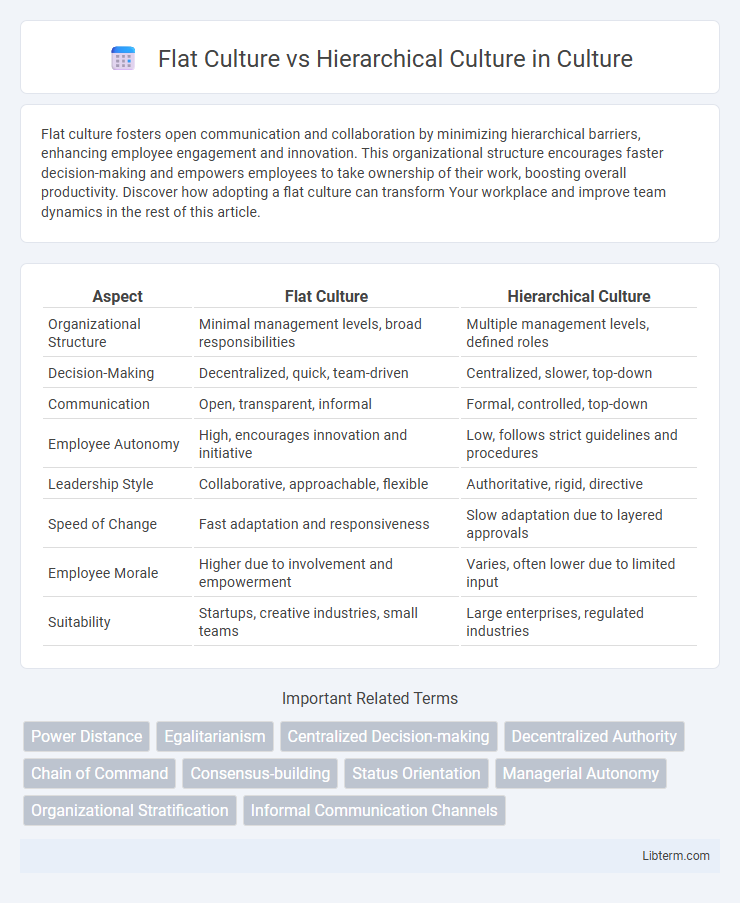Flat culture fosters open communication and collaboration by minimizing hierarchical barriers, enhancing employee engagement and innovation. This organizational structure encourages faster decision-making and empowers employees to take ownership of their work, boosting overall productivity. Discover how adopting a flat culture can transform Your workplace and improve team dynamics in the rest of this article.
Table of Comparison
| Aspect | Flat Culture | Hierarchical Culture |
|---|---|---|
| Organizational Structure | Minimal management levels, broad responsibilities | Multiple management levels, defined roles |
| Decision-Making | Decentralized, quick, team-driven | Centralized, slower, top-down |
| Communication | Open, transparent, informal | Formal, controlled, top-down |
| Employee Autonomy | High, encourages innovation and initiative | Low, follows strict guidelines and procedures |
| Leadership Style | Collaborative, approachable, flexible | Authoritative, rigid, directive |
| Speed of Change | Fast adaptation and responsiveness | Slow adaptation due to layered approvals |
| Employee Morale | Higher due to involvement and empowerment | Varies, often lower due to limited input |
| Suitability | Startups, creative industries, small teams | Large enterprises, regulated industries |
Understanding Flat and Hierarchical Cultures
Flat culture emphasizes minimal management layers, promoting open communication and employee empowerment, which accelerates decision-making and innovation. Hierarchical culture relies on structured levels of authority, ensuring clear roles and accountability but often slowing information flow and adaptability. Understanding these cultural frameworks helps organizations align management styles with strategic goals and workforce dynamics.
Key Characteristics of Flat Organizational Culture
Flat organizational culture features minimal levels of management and wide spans of control, promoting open communication and faster decision-making. Employees often enjoy greater autonomy and direct access to leadership, enabling increased collaboration and innovation. This culture reduces bureaucratic delays and fosters a sense of ownership and accountability across all team members.
Defining Features of Hierarchical Organizational Culture
Hierarchical organizational culture is defined by clear, structured levels of authority, with formalized rules and procedures guiding employee behavior and decision-making. Communication typically flows top-down, emphasizing control, consistency, and stability within the organization. Employees often experience defined roles and responsibilities, limited autonomy, and a strong emphasis on respect for hierarchy and chain of command.
Communication Styles: Flat vs Hierarchical
Flat culture promotes open, transparent communication where employees at all levels freely share ideas and feedback, fostering collaboration and rapid decision-making. Hierarchical culture relies on formal, top-down communication channels with clearly defined roles, leading to controlled information flow and slower feedback loops. These contrasting communication styles impact organizational agility and employee empowerment significantly.
Decision-Making Processes in Both Cultures
Decision-making in flat cultures emphasizes collaboration and collective input, promoting faster consensus due to fewer management layers. Hierarchical cultures rely on top-down decision-making, where authority is centralized and decisions flow through multiple levels, often resulting in slower but more structured processes. The contrast impacts organizational agility, with flat cultures enabling rapid adaptation and hierarchical cultures ensuring control and accountability.
Leadership Roles and Authority Distribution
Flat cultures emphasize decentralized leadership roles where authority is distributed evenly among team members, fostering collaboration and quick decision-making. Hierarchical cultures rely on clearly defined leadership positions with top-down authority distribution, ensuring control and structured communication within the organization. Leadership effectiveness in flat cultures depends on empowerment and influence, whereas hierarchical cultures prioritize formal power and chain of command.
Employee Engagement and Motivation
Flat culture enhances employee engagement by promoting open communication and empowering individuals with greater autonomy, leading to increased motivation and innovation. In contrast, hierarchical culture often results in clear roles and structured processes, which can provide stability but may suppress creativity and reduce employee initiative. Organizations with flat structures typically experience higher motivation due to a sense of ownership and direct influence on decision-making, while hierarchical models rely on top-down directives that might limit employee involvement.
Innovation and Flexibility Comparison
Flat culture organizations foster innovation and flexibility by promoting open communication, faster decision-making, and employee empowerment, which encourages creative problem-solving and adaptation to change. In contrast, hierarchical culture structures often slow innovation due to multiple layers of approval and rigid protocols, limiting swift responses to market shifts and reducing flexibility. Companies with flat cultures typically experience higher agility and a continuous flow of innovative ideas, enhancing competitive advantage in dynamic industries.
Challenges and Risks of Each Culture
Flat culture faces challenges such as unclear authority and decision-making bottlenecks due to minimal management layers, potentially leading to role ambiguity and accountability issues. Hierarchical culture risks slow communication and reduced innovation, as rigid structures can suppress employee autonomy and delay problem-solving. Both cultures must address balancing efficiency with adaptability to prevent decreased organizational effectiveness.
Choosing the Right Culture for Your Organization
Selecting the right organizational culture between flat and hierarchical structures depends on factors such as company size, decision-making speed, and communication flow. Flat cultures foster open communication and faster innovation by reducing management layers, ideal for startups and creative industries. Hierarchical cultures provide clear roles and accountability, benefiting large organizations that require structured processes and consistent decision-making frameworks.
Flat Culture Infographic

 libterm.com
libterm.com